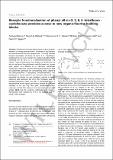Files in this item
Benzylic functionalisation of phenyl all-cis-2, 3, 5, 6-tetrafluorocyclohexane provides access to new organofluorine building blocks
Item metadata
| dc.contributor.author | Bykova, Tetiana | |
| dc.contributor.author | Al-Maharik, Nawaf | |
| dc.contributor.author | Slawin, Alexandra M. Z. | |
| dc.contributor.author | Buehl, Michael | |
| dc.contributor.author | Lebl, Tomas | |
| dc.contributor.author | O'Hagan, David | |
| dc.date.accessioned | 2019-07-30T23:41:15Z | |
| dc.date.available | 2019-07-30T23:41:15Z | |
| dc.date.issued | 2018-07-31 | |
| dc.identifier | 253355716 | |
| dc.identifier | 6272adba-c132-4743-ad65-7dbe5b4db26f | |
| dc.identifier | 85050743011 | |
| dc.identifier | 000443804100030 | |
| dc.identifier.citation | Bykova , T , Al-Maharik , N , Slawin , A M Z , Buehl , M , Lebl , T & O'Hagan , D 2018 , ' Benzylic functionalisation of phenyl all- cis -2, 3, 5, 6-tetrafluorocyclohexane provides access to new organofluorine building blocks ' , Chemistry - A European Journal , vol. Early View . https://doi.org/10.1002/chem.201802166 | en |
| dc.identifier.issn | 0947-6539 | |
| dc.identifier.uri | https://hdl.handle.net/10023/18207 | |
| dc.description | The Royal Society is thanked for support through its Wolfson Research Merit Award Scheme (DO’H). | en |
| dc.description.abstract | Selectively fluorinated hydrocarbons continue to attract attention for tuning pharmacokinetic properties in agrochemical and pharmaceutical discovery programmes. This study identifies benzylic bromination of phenyl all cis-2, 3, 5, 6–tetrafluoro- cyclohexane 2 as a key reaction for accessing building blocks Selectively fluorinated hydrocarbons continue to attract attention for tuning pharmacokinetic properties in agrochemical and pharmaceutical discovery programmes. This study identifies benzylic bromination of phenyl all‐cis‐2,3,5,6‐tetrafluorocyclohexane 2 as a key reaction for accessing building blocks containing the all‐cis‐2,3,5,6‐tetrafluorocyclohexane ring system. These cyclohexanes are of interest as the fluorines are only on one face of the cyclohexane, and this imparts an unusual polar aspect, very different to an otherwise hydrophobic cyclohexane. Ritter type reactions of benzyl bromide 4 with DMF and acetonitrile generated the corresponding benzyl alcohol 6 and benzylacetamide 7 respectively. Benzylacetamide 7 was hydrolysed to benzyl amine 8 and syn‐amino‐alcohol 9 , and separately the phenyl ring was oxidatively cleaved to furnish carboxylic acid acetamide 10 , which after hydrolysis gave the tetrafluorocyclohexyl amino acid 11 . A trans‐halogenation of benzylbromide 4 with AgF2 gave benzyl fluoride 13 . Oxidative cleavage of the aryl ring then gave pentafluorocyclohexyl carboxylic acid 14 . This carboxylic acid was readily converted to amides 23 – 26 and the preferred conformations of these α‐fluoroamides were explored by DFT, X‐ray structure and 1H–19F HOESY NMR analysis. | |
| dc.format.extent | 1696225 | |
| dc.format.extent | 3315348 | |
| dc.language.iso | eng | |
| dc.relation.ispartof | Chemistry - A European Journal | en |
| dc.subject | Organofluorine | en |
| dc.subject | Hydrocarbons | en |
| dc.subject | Fluorinated building blocks | en |
| dc.subject | Ritter reaction | en |
| dc.subject | Conformational analysis | en |
| dc.subject | QD Chemistry | en |
| dc.subject | NDAS | en |
| dc.subject.lcc | QD | en |
| dc.title | Benzylic functionalisation of phenyl all-cis-2, 3, 5, 6-tetrafluorocyclohexane provides access to new organofluorine building blocks | en |
| dc.type | Journal item | en |
| dc.contributor.institution | University of St Andrews. School of Chemistry | en |
| dc.contributor.institution | University of St Andrews. EaSTCHEM | en |
| dc.contributor.institution | University of St Andrews. Biomedical Sciences Research Complex | en |
| dc.identifier.doi | 10.1002/chem.201802166 | |
| dc.description.status | Peer reviewed | en |
| dc.date.embargoedUntil | 2019-07-31 |
This item appears in the following Collection(s)
Items in the St Andrews Research Repository are protected by copyright, with all rights reserved, unless otherwise indicated.


